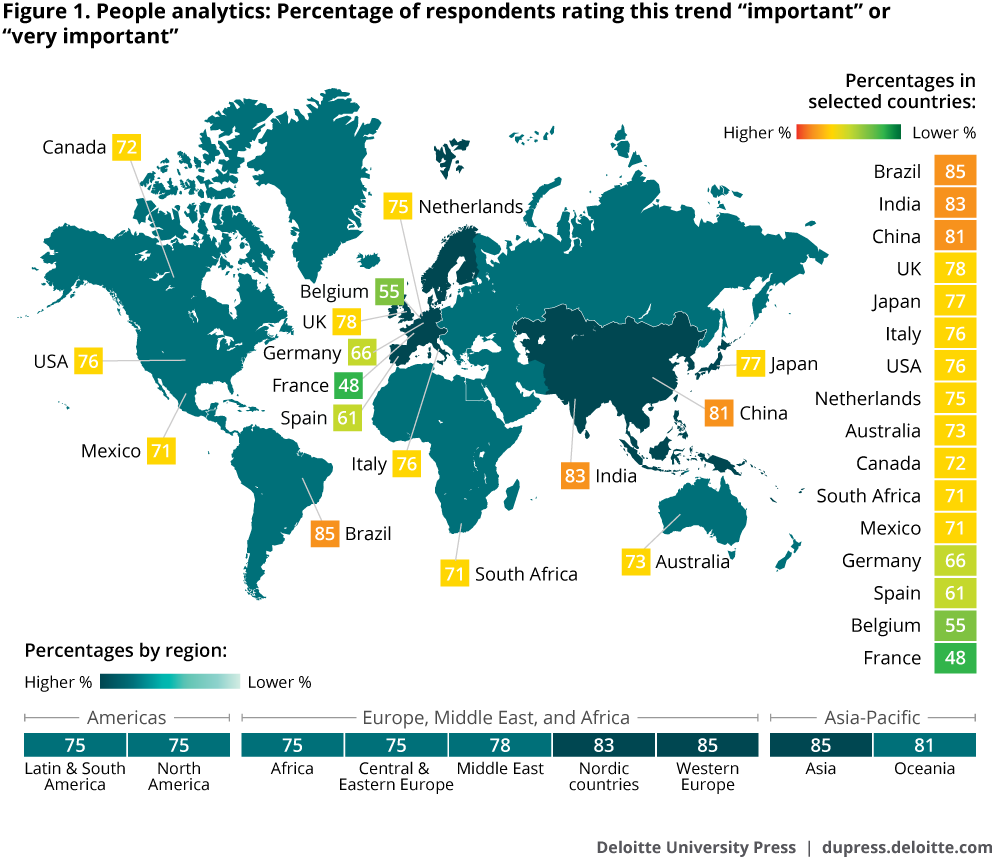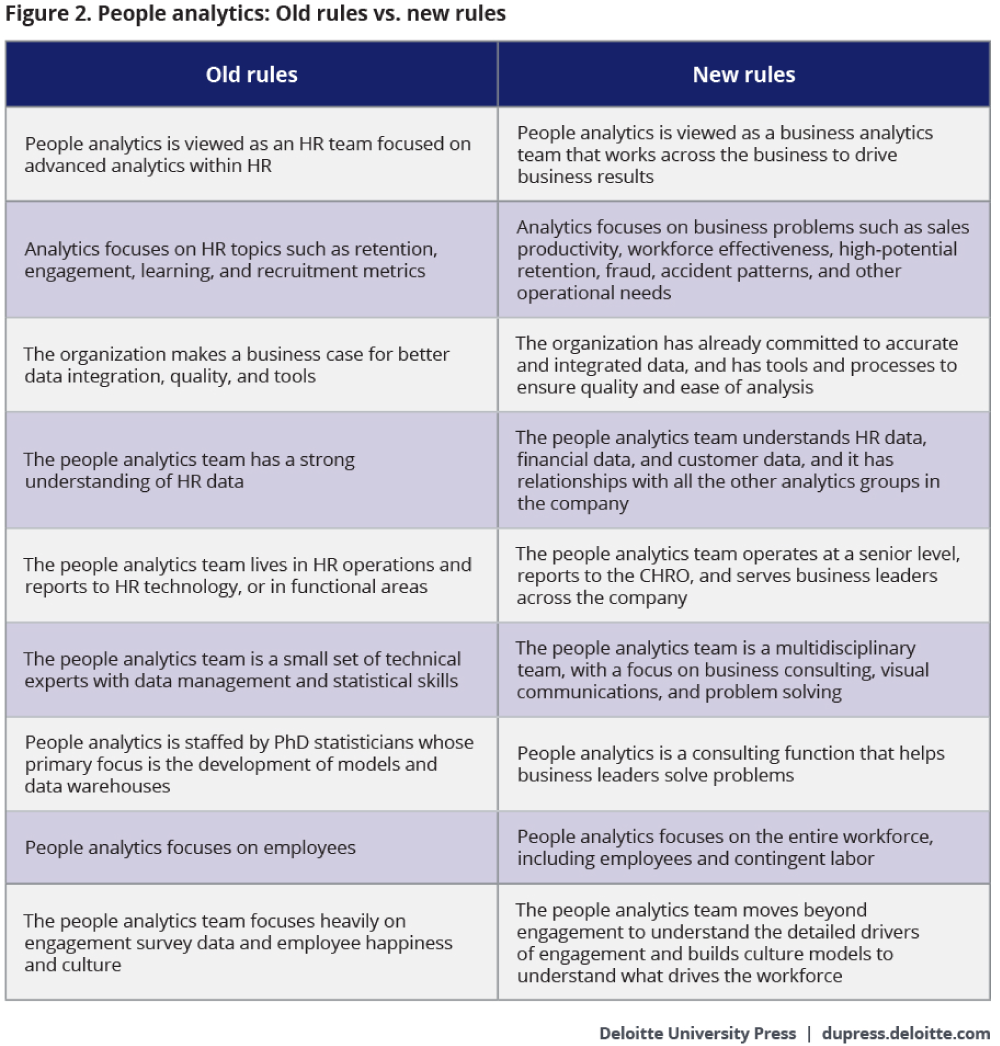People analytics: Recalculating the route has been saved

People analytics: Recalculating the route 2017 Global Human Capital Trends
28 February 2017
Analytics is no longer about finding interesting information and flagging it for managers. Now, data are being used to understand every part of a business operation, and analytical tools are being embedded into day-to-day decision making.
Introduction
Learn More
View 2017 Global Human Capital Trends
Create and download a custom PDF
Explore the infographic
Watch the video
People analytics in HR is undergoing a seismic shift. Driven by the widespread adoption of cloud HR systems, companies are investing heavily in programs to use data for all aspects of workforce planning, talent management, and operational improvement. People analytics, a discipline that started as a small technical group that analyzed engagement and retention, has now gone mainstream. Organizations are redesigning their technical analytics groups to build out digitally powered enterprise analytics solutions. These new solutions, whether developed internally or embedded in new digital solutions, are enabling organizations to conduct real-time analytics at the point of need in the business process. This allows for a deeper understanding of issues and actionable insights for the business.
- While 71 percent of companies see people analytics as a high priority in their organizations (31 percent rate it very important), progress has been slow. The percentage of companies correlating HR data to business outcomes, performing predictive analytics, and deploying enterprise scorecards barely changed from last year.
- Analytics is being applied to a wide range of business challenges: Recruiting remains the No. 1 area of focus, followed by performance measurement, compensation, workforce planning, and retention. We see an explosive growth in the use of organizational network analysis (ONA) and the use of “interaction analytics” (studying employee behavior) to better understand opportunities for business improvement.
- Readiness remains a serious issue: After years of discussing this issue, only 8 percent report they have usable data; only 9 percent believe they have a good understanding of which talent dimensions drive performance in their organizations; and only 15 percent have broadly deployed HR and talent scorecards for line managers.
The function of people analytics, which involves using digital tools1 and data to measure, report, and understand employee performance, is going through a major shift. After years of investing in cloud HR platforms and specialist teams, CHROs and business leaders are not getting the results they want. No longer is analytics about finding interesting information and flagging it for managers: It is now becoming a business function focused on using data to understand every part of a business operation, and embedding analytics into real-time apps and the way we work. In the context of mobile maps, it is time to “recalculate the route.”

New tools provide deep new insights to drive performance
Stakeholders—especially board members and CEOs—are driving this change. Senior leaders are impatient with HR teams that can’t deliver actionable information and insights; therefore, analytics is shifting from a focus on HR to a focus on the business itself. For example:
- Leading ERP vendors are implementing a set of people analytics dashboards available to the CEO, to help senior leaders understand attrition, hiring metrics, employee cost, and employee engagement by geography, business unit, and manager.
- The chief operating officer at a large chain of hospitals uses analytics to understand patterns of patient outcomes and how management and people issues contribute to results.2
- The sales organization at a major consumer products company has partnered with HR to develop a complete model for sales productivity, which helps predict and diagnose problems, pinpoint training solutions, and improve quality of hiring.3
- A retail head of operations now uses business and people analytics to look at customer and employee traffic patterns, identifying new locations where sales people should be positioned to help improve total customer purchase.4
For companies that have been investing in this area for years, it is now easier to get these answers than ever before. Predictive analytics tools from many HR technology vendors have arrived, making it possible to analyze data regarding recruitment, performance, employee mobility, and other factors. Executives now have access to a seemingly endless combination of metrics to help them understand, at a far deeper level, what drives results.5
Moving beyond the analysis of employee engagement and retention, analytics and AI have come together, giving companies a much more detailed view of management and operational issues to improve operational performance. For example:
- Data-driven tools can now help predict patterns of fraud, show trust networks, conduct ONA, show real-time correlations between coaching and engagement, and even analyze employee patterns for time management driven by email and calendar data.6
- Artificial intelligence software can now analyze video interviews and help assess candidate honesty and personality through software.7
- Tools can now analyze hourly labor8 and immediately identify patterns of overtime and other forms of payroll leakage, enabling improvements of millions of dollars through improved practices in workforce management.
- Off-the-shelf retention models (once only useful if bespoke) are now available from SAP, Oracle, Workday, ADP, Ultimate Software, and others, making it easier than ever to understand drivers for attrition.
- Deloitte and other companies are now looking at travel data, billing hours, and other human performance data to help employees improve their levels of energy, wellness, and business performance.
The big trend in 2017 is that these new solutions are business driven, not internally HR focused, challenging HR departments to move beyond their own internal view of data and leveraging people data for a broad range of business problems.
Imagining new uses for data to drive business results
Traditional HR organizations set up an analytics team as a separate group of specialists. Today, companies are rethinking HR as an “intelligent platform” and embedding analytics into their entire workforce management process and operations. A large telecommunications company in India analyzes the time to productivity of every new hire across the company, giving line managers and corporate leaders a dashboard to note when people are behind in their onboarding process.9 Uber’s operations team collects data on how quickly drivers can pick up food in response to requests to improve customer service and enhance productivity.10 Several of our large clients have now used ONA to analyze the behavior of high-performing teams to understand how work is done, helping teams become smarter.
As we discuss in the talent acquisition trend,11 analytics is now becoming a critical part of high-performance hiring. Companies use interview data, careful parsing of job posting language, and candidate screening data to reduce unconscious bias in recruiting. New tools that look at social and local hiring data help companies identify people who are “likely to look for new jobs” much before they are even approached by competitors.12 The use of external data for people analytics has grown significantly, as more than 50 percent of companies now actively use social network and external data to understand attrition, retention, and other performance metrics.
HR’s role is shifting
While widespread adoption might be limited, people analytics has grown from a technical specialist group to a serious business function that must meet the needs of many stakeholders throughout the company. In short, the ability to analyze huge amounts of data should be more of a business-wide function, not limited to HR.
Given this shift, there is a growing consensus that the best analytics programs are owned by a dedicated, multidisciplinary group. Perhaps this function will eventually be decentralized, but for now, centralization yields a stronger analytics result. Some organizations place this in HR, while others build a center of expertise outside HR. For instance, Ford and others have expanded the people analytics function to work across all segments of the business, including finance, HR, and operations.13
More and more analytics is shifting from “pull” to “push,” where the analytics team no longer simply builds models and does projects but now develops dashboards and tools that help managers and employees see relevant data in real time. One of our clients built a “talent management dashboard” that analyzes 10 different measures of team engagement and performance, and delivers this information to all team leaders and senior managers throughout the company. Versions of this are available to senior executives, helping them understand hiring, management, and performance issues around the company in real time.14
The quality of data in HR continues to be a challenge. New cloud HR technology helps tremendously, but clients tell us the problem requires a systemic solution. Companies must now worry about data quality at all levels, put in place privacy and anonymity policies, and carefully implement practices to protect employee data from theft and abuse. And advanced companies now have governance teams that make sure all people-related data are coordinated as the company reorganizes, acquires others, and implements new systems.
Just as spreadsheets were once a tool of finance alone but are now used throughout business, people analytics is making a similar leap. Businesses and organizations that are adopting analytics are bringing it into the core of their business and using it to inform business strategy. Success in analytics will require a prolonged time commitment and continued investment.
Lessons from the front lines
A good example of the new role of people analytics is the journey Chevron has taken to build a global, world-class analytics function.15 Falling oil prices in recent years has required Chevron to find new ways to maintain its above-average profitability and revenue per employee. To achieve this goal, the company used analytics to focus more deeply on understanding workforce productivity.
Chevron began with a small, centralized HR analytics group that provided reports and standardized people metrics at headquarters. Previously, there was little sense of community among the various HR specialty areas and business units, leading to great variability in their practices, operating procedures, and capabilities. Different areas of the business were duplicating data collection and analysis methods to generate the same reports.
To solve these problems, the team redefined its mission: “to support Chevron’s business strategies with better, faster workforce decisions informed by data.” This expanded vision led Chevron to reinvent its analytics team as a company-wide community of practice and establish a global process to prioritize all people analytics projects in the company.
The community of practice totaled 295 members, across all important divisions of the company, including HR business partners, specialists, and analysts from around the world. It provides a forum for interested analytics professionals in the organization to gather virtually and discuss data models, share data, showcase new techniques, design standardized metrics, and develop analytics programs. The core team also developed an in-house workforce analytics curriculum aimed at developing critical analytics competencies in both HR and non-HR stakeholders. Because analytics involves a range of skills—from problem solving and data analysis to visualization and statistics—this curriculum helps team members gain a common level of understanding and capability.
The results have been significant. Only two years after the reinvention of people analytics, the team is now performing dozens of analytics projects. Chevron’s people analytics practice has dramatically reduced time to complete an analytics project and increased reliability for all people-related decisions; the company now has standard reports across the business for all talent metrics; and the team is widely consulted for decisions on reorganization, restructuring, and other strategic business decisions. Compared with the prior decentralized model, the new model operates at significantly lower cost yet achieves 30 percent higher productivity, doing more work with significantly fewer people and in significantly less time. One business unit alone eliminated nearly 100 hours of redundant reporting work in 2015.
Start here
Our research and consulting work have identified the following eight factors as important to creating a successful people analytics program:
- Invest at a senior level in people analytics: The function should provide global support, not just technical analysis, and requires CHRO and senior executive support, technical resources from IT, and a strong business-focused leader.
- Establish clear leadership: A single team and leader should own the initial stages of an analytics effort, even if that capability eventually becomes decentralized.
- Prioritize clean and reliable data across HR and the organization: Analyses are only as good as the data fed into tools and software. Working with consistent, timely, and accurate data is foundational to all analytics practices. Take concrete steps to ensure that data quality is a part of every analytics discussion. Educate HR’s stakeholders and implement data governance programs to clean and maintain data accuracy and consistency across HR and operational data stores.
- Understand that analytics is multidisciplinary: Bring together a multidisciplinary group from across the organization, not just PhDs and statisticians. Technical analysis is only a small part of the function. Data function, data quality, business knowledge, data visualization, and consulting skills are all critical to success.
- Increase analytics fluency throughout the organization: Regardless of whether the analytics customers do the analysis themselves or have specialists supporting them, training for both HR and other business functions will be critical to operating at scale. Identify a curriculum or other partner to help with education, implementation of standard tools, and standardization of reports and dashboards.
- Develop a two- to three-year roadmap for investment in analytics programs: This investment is aimed at building a new business function for the company, not just a technical team within HR.
- Focus on actions, not just findings: To provide value, the analytics team must translate information into solutions, and stakeholders must take action.
- Integrate HR, organizational, and external data: Advanced people analytics programs increasingly rely on the intersection of data from HR, operations, and external sources. Organizations require a data strategy that encourages the integration and use of structured and unstructured data from internal and external sources.
Fast forward
Over the next few years, the number of data sources will continue to rise, leading to a fusion of external and internal data in predicting employee behavior. At leading companies, analytics will become even more interdisciplinary, along the lines of ONA. Eventually, people analytics will be fully integrated into systems and always in the background, rather than a separate source of information.
Going forward, analytics technology will have the capability to deliver increasingly personalized recommendations. Due to the sensitive nature of some people analytics programs, organizations will likely need to become far more serious about data confidentiality, local regulation regarding the use of employee data, and the risk of public disclosure of private information on the organization and its employees.

Deloitte’s Human Capital professionals leverage research, analytics, and industry insights to help design and execute the HR, talent, leadership, organization, and change programs that enable business performance through people performance. Visit the Human Capital area of www.deloitte.com to learn more.


